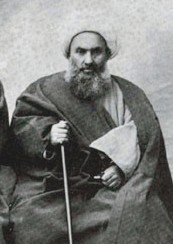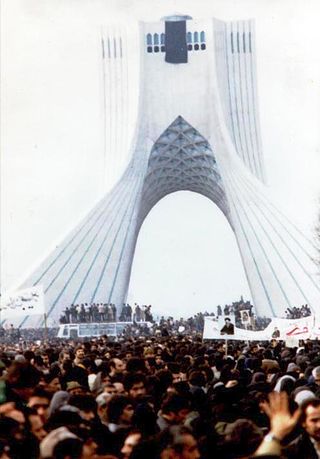The term Islamic republic has been used in different ways. Some Muslim religious leaders have used it as the name for a form of Islamic theocratic government enforcing sharia, or laws compatible with sharia. The term has also been used for a sovereign state taking a compromise position between a purely Islamic caliphate and a secular, nationalist republic.
Special Clerical Court, or Special Court for Clerics is a special Iranian judicial system for prosecuting crimes, both ordinary and political, committed by Islamic clerics and scholars. The Special Clerical Court can defrock and disbar Islamic jurists, give sentences of imprisonment, corporal punishment, execution, etc. The court functions independently of the regular Iranian judicial framework, with its own security and prison systems, "generally secret and confidential" cases, proceedings and procedures, and is accountable only to the Supreme Leader of Iran,. The most senior Islamic politician to be prosecuted and sentenced to prison since the Iranian Revolution was Abdollah Nouri who was sentenced to five years in prison for political and religious dissent by the court in 1999.

The Constitution of the Islamic Republic of Iran is the supreme law of Iran. It was adopted by referendum on 2 and 3 December 1979, and went into force replacing the Constitution of 1906. It has been amended once, on 28 July 1989. The constitution was originally made up of 175 articles in 12 chapters, but amended in 1989 to 177 articles in 14 chapters.

In Islamic Law, tazir lit. scolding; refers to punishment for offenses at the discretion of the judge (Qadi) or ruler of the state. It is one of three major types of punishments or sanctions under Islamic law, Sharia — hadd, qisas / diyya and ta'zir. Contrary to the lightness of naming, tazir are discretionary punishments that can range from a harsh warning from the judge to corporal punishment such as flogging, imprisonment and exile not specified in the Qur'an nor the hadiths, or is not punishable under either qisas or hudud.

Islamic Government, or Islamic Government: Jurist's Guardianship is a book by the Iranian Shi'i Muslim cleric, jurist and revolutionary, Ayatollah Ruhollah Khomeini. First published in 1970, it is perhaps the most influential document written in modern times in support of theocratic rule.

Massoud Rajavi is an Iranian politician and revolutionary who became the leader of the People's Mujahedin of Iran (MEK) in 1979. After leaving Iran in 1981, he resided in France and Iraq. He went missing shortly before the 2003 invasion of Iraq, leaving his then wife and co-leader Maryam Rajavi as the public face of the MEK.

Qisas or Qiṣāṣ is an Islamic term interpreted to mean "retaliation in kind", "eye for an eye", or retributive justice. Qisas and diyya applied as an alternative in cases where retaliation conditions not met are two of several forms of punishment in classical/traditional Islamic criminal jurisprudence, the others being Hudud and Ta'zir.

Diya in Islamic law, is the financial compensation paid to the victim or heirs of a victim in the cases of murder, bodily harm or property damage by mistake. It is an alternative punishment to qisas. In Arabic, the word means both blood money and ransom, and it is spelled sometimes as diyah or diyeh.
The Guardianship of the Islamic Jurist is a concept in Twelver Shia Islamic law which holds that until the reappearance of the "infallible Imam", at least some of the religious and social affairs of the Muslim world should be administered by righteous Shi'i jurists (Faqīh). The nature of these affairs are disputed.
Islamic Revolutionary Court is a special system of courts in the Islamic Republic of Iran designed to try those suspected of crimes such as smuggling, blaspheming, inciting violence, insulting the Supreme Leader, and attempting to overthrow the Islamic government. The court started its work after the 1979 Iranian Revolution.

Khomeinism, also transliterated Khumaynism, refers to the religious and political ideas of the leader of the 1979 Iranian Islamic Revolution, Ruhollah Khomeini. In addition, Khomeinism may also refer to the ideology of the clerical class which has ruled the Islamic Republic of Iran, founded by Khomeini. It can also be used to refer to the "radicalization" of segments of the Twelver Shia populations of Iran, Iraq, and Lebanon, and the Iranian government's "recruitment" of Shia minorities in Afghanistan, Pakistan, Saudi Arabia, and Africa. The words Khomeinist and Khomeinists, derived from Khomeinism, can also be used to describe members of Iran's clerical rulers and attempt to differentiate them from "regular" Shia Muslim clerics.

Sheikh Fazlollah bin Abbas Mazindarani, also known as Fazlollah Noori, was a major figure in Iranian Constitutional Revolution (1905-1911) as a Twelver Shia Muslim scholar and politically connected mullah of the court of Iran's Shah. Originally a supporter of the constitution, he turned against it after the supporting constitution shah died and was replaced by one opposing the constitution. He was hanged as a traitor in 1909 by a court of the constitutionalist government for "sowing corruption and sedition on earth".

From the Imperial Pahlavi dynasty, through the Islamic Revolution (1979), to the era of the Islamic Republic of Iran, government treatment of Iranian citizens' rights has been criticized by Iranians, international human rights activists, writers, and NGOs. While the monarchy under the rule of the shahs was widely attacked by most Western watchdog organizations for having an abysmal human rights record, the government of the Islamic Republic which succeeded it is considered still worse by many.

The Persian Constitutional Revolution, also known as the Constitutional Revolution of Iran, took place between 1905 and 1911 during the Qajar dynasty. The revolution led to the establishment of a parliament in Persia (Iran), and has been called an "epoch-making episode in the modern history of Persia".

Casualties of the Iranian revolution refers to those who lost their lives during the Iranian revolution. Observers differ on how many people died during the Iranian revolution. The current Islamic government uses the figure of 60,000 killed; in reference to this figure, the military historian Spencer C. Tucker notes that "Khomeini's regime grossly overstated the revolution's death toll for propaganda purposes". The sociologist Charles Kurzman, drawing on later more detailed records from the Islamic Republic, believes the number was closer to 2,000-3,000.
The Imperial State of Iran, the government of Iran during the Pahlavi dynasty, lasted from 1925 to 1979. During that time two monarchs — Reza Shah Pahlavi and his son Mohammad Reza Shah Pahlavi — employed secret police to stifle political dissent. The Pahlavi dynasty has sometimes been described as a "royal dictatorship", or "one-man rule". According to one history of the use of torture by the state in Iran, abuse of prisoners varied at times during the Pahlavi reign.
The ideology of the Iranian revolution has been called a "complex combination" of Pan-Islamism, political populism, and Shia Islamic "religious radicalism"; "a struggle against paganism, oppression, and empire." Perhaps the most important of the diverse ideological interpretation of Islam within the grand alliance that led to the 1979 revolution were Khomeinism, Ali Shariati’s Islamic-left ideology, Mehdi Bazargan’s liberal-democratic Islam. Less powerful were the socialist guerrilla groups of Islamic and secular variants, and the secular constitutionalism in socialist and nationalist forms. Contributors to the ideology also included Jalal Al-e-Ahmad, who formulated the idea of Gharbzadegi—that Western culture must be rejected and fought as was a plague or an intoxication that alienated Muslims from their roots and identity.
Sharia means Islamic law based on Islamic concepts based from Quran and Hadith. Since the early Islamic states of the eighth and ninth centuries, Sharia always existed alongside other normative systems.

The Islamic Republic of Iran was founded after the 1979 overthrow of the Pahlavi dynasty by the Islamic Revolution, and its legal code is based on Islamic law or sharia, although many aspects of civil law have been retained, and it is integrated into a civil law legal system. According to the constitution of the Islamic Republic, the judiciary in Iran "is an independent power". The entire legal system—"from the Supreme Court to regional courts, all the way down to local and revolutionary courts"—is under the purview of the Ministry of Justice, but in addition to a Minister of Justice and head of the Supreme Court, there is also a separate appointed Head of the Judiciary. Parliamentary bills pertaining to the constitution are vetted by the Council of Guardians.

Shia Islamism is the usage of Shia Islam in politics. Most study and reporting on Islamism has been focused on Sunni Islamist movements. Shia Islamism, a previously very small ideology, was boosted after the Iranian Revolution led by Ruhollah Khomeini, whose Shia Islamist policies became known as Khomeinism.











